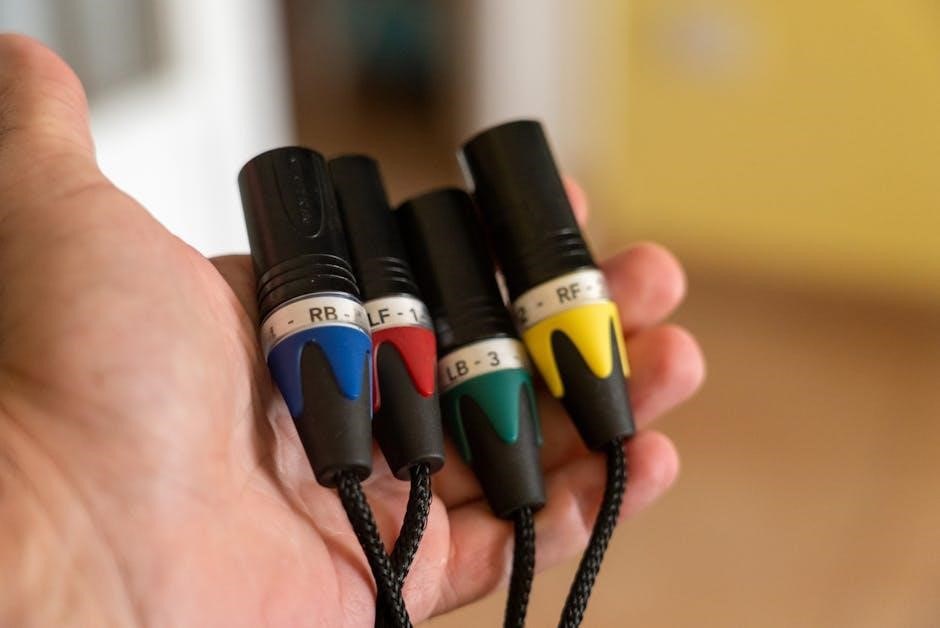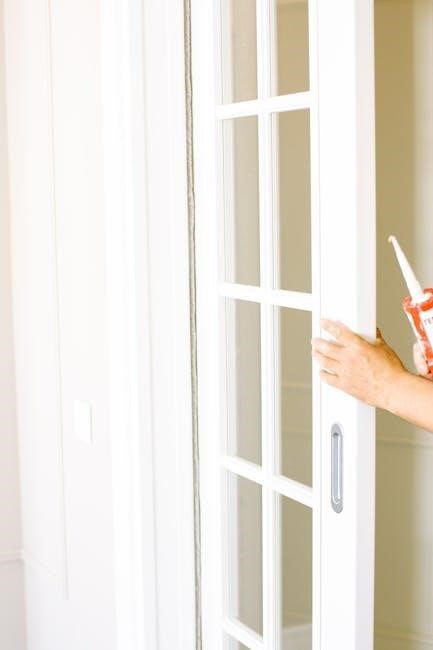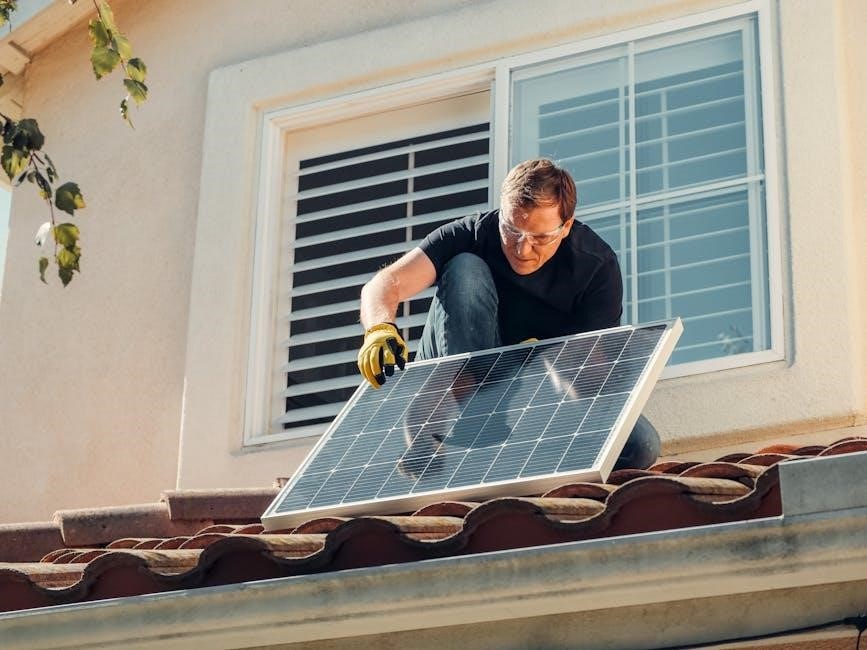The Honeywell T4 Pro Series Thermostat is a programmable, energy-efficient device designed for easy management of home heating and cooling systems. Features include smart scheduling, energy-saving modes, and compatibility with various HVAC systems. This guide provides step-by-step installation and setup instructions to ensure optimal performance and comfort.
1.1 Overview of the T4 Thermostat
The Honeywell T4 Pro Series Thermostat is a programmable device designed for efficient heating and cooling management. It offers compatibility with various HVAC systems, including heat pumps, and supports up to 2-heat and 1-cool stages. The thermostat features a clear, user-friendly interface and programmable modes for tailored temperature control. Its design ensures easy installation, with wiring options from the back or below, making it accessible for both professionals and DIY enthusiasts. The T4 thermostat also includes smart scheduling and energy-saving features, promoting comfort and efficiency. With its robust functionality and intuitive setup, the T4 thermostat is an ideal choice for modern home automation and climate control.
1.2 Importance of Proper Installation
Proper installation of the T4 thermostat is crucial for ensuring safety, efficiency, and optimal performance. Incorrect wiring or setup can lead to system malfunctions, increased energy consumption, or even safety hazards. Always switch off the mains power before accessing wiring to prevent electrical shocks or damage. The thermostat must be installed by a competent person, as improper handling of electrical components can void the warranty or cause operational issues. Correct installation ensures accurate temperature control, energy savings, and seamless integration with your HVAC system. Following the installation manual carefully helps avoid common mistakes, such as short circuits or incorrect stage configuration. A well-installed T4 thermostat guarantees reliable operation and enhances your home’s comfort and energy efficiency.
System Requirements and Compatibility
The Honeywell T4 Pro Series Thermostat is compatible with various HVAC systems, including heat pumps, dual-fuel, and traditional systems, ensuring versatile and efficient temperature control.
2.1 Compatible HVAC Systems
The Honeywell T4 Pro Series Thermostat is designed to work seamlessly with a wide range of HVAC systems, including heat pumps, dual-fuel systems, and conventional heating and cooling units. It supports up to 2 heat stages and 1 cool stage, making it suitable for various home configurations. Additionally, it is compatible with both gas and electric systems, ensuring flexibility for different energy sources. This versatility allows homeowners to enjoy efficient temperature control regardless of their existing HVAC setup. Proper compatibility ensures optimal performance and energy savings, making the T4 thermostat a reliable choice for many households.
2.2 Necessary Tools and Materials
For a successful T4 thermostat installation, gather the following tools and materials: a screwdriver set, wire strippers, a voltage tester, and a drill with wall anchors. Ensure you have the thermostat unit, its mounting plate, and all provided screws. Additionally, verify the wiring compatibility with your HVAC system. A mini centrifuge or automatic dispensers may be needed for specific setups, though typically not required for standard installations. Always turn off the power supply before starting work. Consult the manual for any system-specific tools. Proper preparation ensures a smooth and safe installation process.

Safety Precautions
Always disconnect the power supply before handling electrical components. Avoid touching live wires and ensure all connections are secure. Use a voltage tester to confirm power is off.
3.1 Power Safety Guidelines
To ensure your safety, always switch off the main power supply before accessing the thermostat or any wiring. Verify the power is off using a voltage tester. Never touch electrical components with wet hands or while standing on a conductive surface. Keep children away from the installation area. If you are unsure about any step, consult a licensed electrician. Properly securing the UWP door ensures it remains closed without bulging, preventing potential electrical hazards. Always follow the manufacturer’s instructions for handling and connecting wires to avoid short circuits or system damage. Power safety is crucial to prevent injuries and ensure a reliable installation.
3.2 Handling Electrical Components
When handling electrical components of the Honeywell T4 Pro Series Thermostat, always ensure the main power supply is switched off. Use a voltage tester to confirm the absence of electricity before proceeding. Avoid touching wires or terminals with wet hands or while standing on conductive surfaces. Never force wires into connectors, as this could cause damage. Carefully push excess wire back into the wall to prevent any electrical hazards. Avoid over-bending wires, as this can lead to breakage. If unsure about any step, consult a licensed electrician. Proper handling ensures a safe and reliable installation.

Pre-Installation Checklist
Before starting, verify HVAC system compatibility, gather all necessary tools and materials, and ensure the installation site is clear and accessible. Check existing wiring and prepare for a safe, efficient setup.
4.1 Verifying System Compatibility
Verifying system compatibility is crucial before installing the T4 thermostat. Ensure your HVAC system supports the thermostat’s features, such as heat pumps or dual-fuel systems. Check the wiring configuration to match the thermostat’s terminal connections. Refer to the user manual for specific compatibility details. Also, confirm that the thermostat supports the required heating and cooling stages for your system. Proper compatibility ensures seamless operation and optimal performance. Always consult the installation manual or contact customer support if unsure about system compatibility. This step prevents potential installation issues and guarantees efficient functionality.
4.2 Gathering Required Tools
Before starting the installation, gather all necessary tools to ensure a smooth process. You will need a screwdriver set (both flathead and Phillips), wire strippers, a voltage tester, and a drill with appropriate drill bits. Additionally, a ladder or step stool may be required for accessing the thermostat location. If mounting on a concrete or brick wall, a wall anchor kit is essential. A pencil and marker are useful for marking wire locations and connections. Include a small container to organize screws and wires. Always refer to the thermostat’s manual for specific tools recommended by the manufacturer. Having all tools ready saves time and ensures a safe, efficient installation.

Wiring Diagrams and Connections
The wiring diagrams provide a clear visual guide for connecting the thermostat to your HVAC system. Follow the color-coded wires and ensure proper connections for safe and efficient operation.
5.1 Understanding the Wiring Diagram
The wiring diagram is a critical tool for installing the T4 thermostat, providing a visual representation of connections between the thermostat and HVAC system. It outlines color-coded wires, such as R (red) for 24V power, W (white) for heating, Y (yellow) for cooling, G (green) for fan, and C (common) for neutral. Each terminal corresponds to specific functions, ensuring proper system operation. The diagram also distinguishes between 2-heat, 1-cool stage systems and more complex configurations. By matching wires to their designated terminals, you ensure safe and efficient thermostat performance. Always verify compatibility with your HVAC system type before proceeding. This step is essential for avoiding errors and ensuring optimal functionality.
5.2 Connecting Wires to the Thermostat
Connecting wires to the T4 thermostat requires careful attention to the wiring diagram to ensure proper functionality. Begin by matching each wire to its corresponding terminal, such as R (24V power), W (heating), Y (cooling), G (fan), and C (common). Turn off the power supply to the HVAC system before starting. Strip the insulation from the wire ends and securely attach them to the thermostat terminals. Gently push excess wire back into the wall to keep the installation neat. Close the terminal platform and ensure all connections are firm. Double-check the wiring diagram to confirm accuracy. Proper connections are essential for safe and efficient operation of the thermostat.
5.3 Testing Wiring Connections
After connecting the wires to the thermostat, perform a thorough test to ensure all connections are correct and functioning properly. Restore power to the HVAC system and turn on the heating and cooling systems one at a time. Verify that each mode operates as expected, checking for proper activation of the fan, heating, and cooling units. Use a multimeter to test voltage at the thermostat terminals if necessary. Ensure there are no short circuits or open connections.
Additionally, check the thermostat’s display for any error messages. If everything functions correctly, the wiring connections are secure and the thermostat is ready for programming.
This step ensures reliable performance and prevents potential issues.

Mounting the Thermostat
Mounting the T4 thermostat involves preparing the wall, aligning the device, and securing it firmly. Ensure the surface is level and use provided hardware for stability. Avoid over-tightening to prevent damage.
6.1 Preparing the Wall for Installation
Before mounting the T4 thermostat, ensure the wall surface is clean, dry, and level. If replacing an old thermostat, remove any adhesive residue or screws. Push excess wire back into the wall to avoid interference. Check if the wall requires spackling or sanding to create a smooth surface. Use the provided wall anchors or screws to secure the mounting plate firmly. Ensure the plate is aligned straight and level to prevent installation issues. If the old thermostat had a larger footprint, fill gaps with spackling compound and sand smooth. This preparation ensures a secure and professional-looking installation.
6.2 Aligning and Securing the Thermostat
Once the wall is prepared, align the thermostat with the mounting plate, ensuring it is straight and level. Gently press the device onto the plate until it clicks securely into place. Check that all edges are flush with the wall for a seamless fit. Tighten the screws provided to hold the thermostat firmly without over-tightening, which could damage the unit. If the thermostat has a UWP door, ensure it remains closed and lies flat against the device. Verify that the screen is responsive and the display is unobstructed. Proper alignment and secure fastening are crucial for the thermostat to function accurately and maintain a professional appearance.

Configuring the Thermostat
After installation, configure the thermostat by selecting your preferred heating and cooling modes, setting temperature limits, and enabling energy-saving features to optimize performance and efficiency.
Start by powering on the thermostat and following the on-screen prompts to select your preferred language and unit of measurement (Fahrenheit or Celsius). Navigate through the menu to set your HVAC system type, ensuring it matches your home’s configuration for proper functionality. Program your daily schedule by setting specific temperature targets for different times of the day, optimizing comfort and energy usage. Use the smart scheduling feature to create a tailored heating and cooling plan that aligns with your lifestyle and preferences. Enable features like energy-saving mode to reduce consumption during periods of inactivity or when you’re away from home. Finally, review your settings and save them to ensure your thermostat operates according to your programmed preferences. To optimize comfort and energy efficiency, create a detailed heating and cooling schedule on your T4 thermostat; Access the scheduling menu and set specific temperature targets for different times of the day. For example, set a lower temperature when sleeping or away from home, and a higher temperature when awake or present. Use the smart scheduling feature to automatically adjust settings based on your daily routine. Customize your schedule for weekdays and weekends, ensuring consistent comfort while minimizing energy waste. Enable energy-saving mode to reduce consumption during inactive periods. Review and adjust your schedule as needed to match your lifestyle and preferences for optimal performance. To adjust temperature settings on the T4 thermostat, navigate to the temperature control menu using the touchscreen or physical buttons. Select the desired mode (Heat, Cool, or Off) and use the arrows to increase or decrease the setpoint temperature. For temporary adjustments, press the “Hold” button to override the current schedule without altering the programmed settings. Energy-saving features allow you to set a lower temperature when away or sleeping and a higher temperature when home or awake. Ensure the temperature aligns with your comfort preferences while maintaining energy efficiency. Regularly review and update temperature settings to adapt to seasonal changes or lifestyle adjustments for optimal performance. The T4 thermostat offers programmable modes, energy-saving features, and smart home integration, allowing seamless control of HVAC systems for enhanced comfort and energy efficiency. The T4 thermostat offers advanced programmable modes, including 7-day scheduling and custom temperature settings. Users can set distinct heating and cooling schedules for different days, optimizing energy use. Features like hold, auto, and manual modes provide flexibility. The thermostat also supports geofencing and smart recovery, learning your system’s behavior to pre-heat or cool for comfort. These modes ensure efficient operation and adaptability to varying household needs. By programming specific temperature ranges, homeowners can reduce energy consumption without compromising comfort. This versatility makes the T4 thermostat a practical choice for modern smart home integration and energy management. The T4 thermostat incorporates advanced energy-saving features to optimize heating and cooling efficiency. Smart recovery mode learns your system’s behavior, pre-heating or cooling to reach your desired temperature just in time. Geofencing technology adjusts settings based on your location, reducing energy use when you’re away. Auto-changeover mode seamlessly switches between heating and cooling to maintain comfort while saving energy. Additionally, the thermostat offers customizable energy reports to track usage and identify savings opportunities. These features ensure your HVAC system operates efficiently, reducing energy consumption and lowering utility bills.
The T4 thermostat seamlessly integrates with popular smart home systems, enhancing convenience and control. Compatibility with platforms like Apple HomeKit and Amazon Alexa allows voice command operation and centralized management of your HVAC system. Smartphone app connectivity enables remote temperature adjustments, scheduling, and energy monitoring. Geofencing technology uses your location to automatically adjust settings, optimizing energy use when you’re away or returning home. Additionally, the thermostat can receive software updates via the internet, ensuring you always have the latest features and improvements. This integration transforms your home into a smarter, more energy-efficient space, offering unparalleled ease of use and connectivity. Regularly clean the thermostat to prevent dust buildup and ensure accurate temperature readings. Check wiring connections for damage or looseness. Reset the device if issues arise. To maintain optimal performance, clean the T4 thermostat regularly. Use a soft, dry cloth to wipe the display and exterior. Avoid harsh chemicals or moisture, as they may damage the device. Gently remove dust from vents or sensors using compressed air. Ensure the thermostat is powered off during cleaning to prevent electrical issues. Regular upkeep helps maintain accurate temperature readings and prolongs the device’s lifespan. Additionally, check for firmware updates to ensure all features function correctly. Proper maintenance ensures the thermostat operates efficiently and reliably, providing consistent heating and cooling control for your home. Always refer to the user manual for specific cleaning instructions. Common issues with the T4 thermostat may include unresponsive screens, incorrect temperature readings, or system connectivity problems. If the screen light stays on or off unexpectedly, check the installation manual for display settings or reset the thermostat. Wiring issues can cause malfunction; ensure all connections are secure and match the wiring diagram. If the thermostat fails to activate heating or cooling, verify system compatibility and power supply. For sensor-related problems, clean the sensor or reposition it for accurate readings. If issues persist, refer to the troubleshooting guide or contact customer support. Regular maintenance and updates can prevent many of these problems, ensuring smooth operation. Always follow safety guidelines when addressing electrical components. Resetting the T4 thermostat can resolve many issues, such as system malfunctions or incorrect settings. To reset, press and hold the “Menu” and “Down” buttons simultaneously for 5-10 seconds until the screen resets. For a factory reset, insert a pin into the small reset hole on the back of the thermostat and hold for 3 seconds. This will restore default settings, so you’ll need to reconfigure preferences. Ensure the power is off before performing a reset to avoid damage. If issues persist after resetting, consult the troubleshooting guide or contact support. Regular resets can help maintain optimal performance and resolve software glitches. Always refer to the manual for specific reset instructions tailored to your model. The T4 thermostat installation process ensures efficient and safe operation. Proper setup guarantees optimal performance, while regular maintenance and troubleshooting maintain reliability. Your thermostat is now ready for consistent comfort. After completing the installation, perform a thorough system check to ensure everything functions correctly. Verify that the thermostat is properly mounted and all wire connections are secure. Test the heating and cooling modes to confirm they activate as programmed. Check the display for any error messages and ensure the schedule is set according to your preferences. Power cycle the system if necessary and review all settings for accuracy. Finally, refer to the user manual for any additional verification steps to ensure your T4 thermostat operates efficiently and maintains your desired comfort levels consistently. To maintain peak performance, regularly clean the thermostat and ensure its sensors are free from dust. Update the software to the latest version for enhanced functionality. Check and replace air filters as recommended to improve efficiency. Periodically review and adjust your heating and cooling schedules to align with your lifestyle. Verify that smart home integrations are functioning correctly for seamless control. Perform routine system checks to identify and address any issues promptly. By following these steps, you can ensure your T4 thermostat operates efficiently, providing consistent comfort and energy savings throughout the year.7.1 Initial Setup and Programming
7.2 Setting Up Heating and Cooling Schedules
7.3 Adjusting Temperature Settings

Advanced Features of the T4 Thermostat
8.1 Programmable Modes and Options
8.2 Energy-Saving Features
8.3 Smart Home Integration

Maintenance and Troubleshooting
9.1 Cleaning and Upkeeping the Thermostat
9.2 Common Issues and Solutions
9.3 Resetting the Thermostat
10.1 Final Checks and Verification
10.2 Ensuring Optimal Performance
